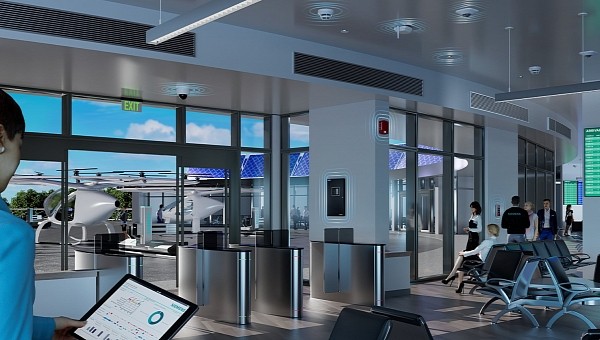The image of a dedicated hub where electric flying taxis are lined up after taking passengers to their destination, and ready to be recharged, still seems like something out of a Sci-Fi movie or videogame. Yet, it’s closer than ever to becoming reality. We can see it in the new wave of AAM (Advanced Air Mobility) infrastructure projects that are taking over the world.
There’s no question about Siemens’ leading role in the electric mobility revolution. Last summer, it became the first external investor in Electrify America, the largest public ultra-fast charging network for all EVs in North America.
A year earlier, Siemens had showcased the prototype of an autonomous EV charging system, at the IAA Mobility event. Together with the expert in autonomous and electric transport systems, Einride AB, Siemens developed this interesting charging concept for e-trucks, and successfully tested one of these trucks being charged completely autonomously.
Through a different branch, Siemens Energy, the global giant has even contributed to making green research vessels for the U.S. government. Its SiSHIP Blue Drive PlusC diesel-electric propulsion system and the BlueVault battery storage solution will be integrated on the future hybrid research vessels operated by the National Oceanographic and Atmospheric Administration (NOAA).
It’s no surprise, then, that Siemens would also dabble into AAM, the world of future electric aircraft. It brings to the table a much-needed expertise in electrification and vehicle charging. On the other hand, its partner in this project, Skyway, will add its experience in air traffic navigation and airspace mission management.
These two sound like the perfect match for the development of future vertiports – those aviation hubs that are specifically designed for the requirements of eVTOL operations. A lot of the other AAM infrastructure projects are focusing more on the air traffic management part, but this one brings a fresh perspective, by looking closer at the energy demand aspect.
After all, effective charging will be essential for regular commercial operations of air taxis. Although it seems like a distant future right now, these new means of transportation could face the same critical issues of time and costs, once hundreds of eVTOLs are in operation. A smooth traffic flow also implies fast aircraft turnaround times. And this can only be achieved through a highly-effective electrical charging system at these future vertiports.
Through this collaboration, Siemens and Skyway want to help standardize vertiport planning and design, while also coming up with a solution to reduce energy consumption as much as possible. And the first step for Siemens is to determine the charging and power requirements for air taxi operations at dedicated vertiports.
This would certainly serve as a great leap for finally developing a network of vertiports across the U.S.
A year earlier, Siemens had showcased the prototype of an autonomous EV charging system, at the IAA Mobility event. Together with the expert in autonomous and electric transport systems, Einride AB, Siemens developed this interesting charging concept for e-trucks, and successfully tested one of these trucks being charged completely autonomously.
Through a different branch, Siemens Energy, the global giant has even contributed to making green research vessels for the U.S. government. Its SiSHIP Blue Drive PlusC diesel-electric propulsion system and the BlueVault battery storage solution will be integrated on the future hybrid research vessels operated by the National Oceanographic and Atmospheric Administration (NOAA).
It’s no surprise, then, that Siemens would also dabble into AAM, the world of future electric aircraft. It brings to the table a much-needed expertise in electrification and vehicle charging. On the other hand, its partner in this project, Skyway, will add its experience in air traffic navigation and airspace mission management.
These two sound like the perfect match for the development of future vertiports – those aviation hubs that are specifically designed for the requirements of eVTOL operations. A lot of the other AAM infrastructure projects are focusing more on the air traffic management part, but this one brings a fresh perspective, by looking closer at the energy demand aspect.
After all, effective charging will be essential for regular commercial operations of air taxis. Although it seems like a distant future right now, these new means of transportation could face the same critical issues of time and costs, once hundreds of eVTOLs are in operation. A smooth traffic flow also implies fast aircraft turnaround times. And this can only be achieved through a highly-effective electrical charging system at these future vertiports.
Through this collaboration, Siemens and Skyway want to help standardize vertiport planning and design, while also coming up with a solution to reduce energy consumption as much as possible. And the first step for Siemens is to determine the charging and power requirements for air taxi operations at dedicated vertiports.
This would certainly serve as a great leap for finally developing a network of vertiports across the U.S.







